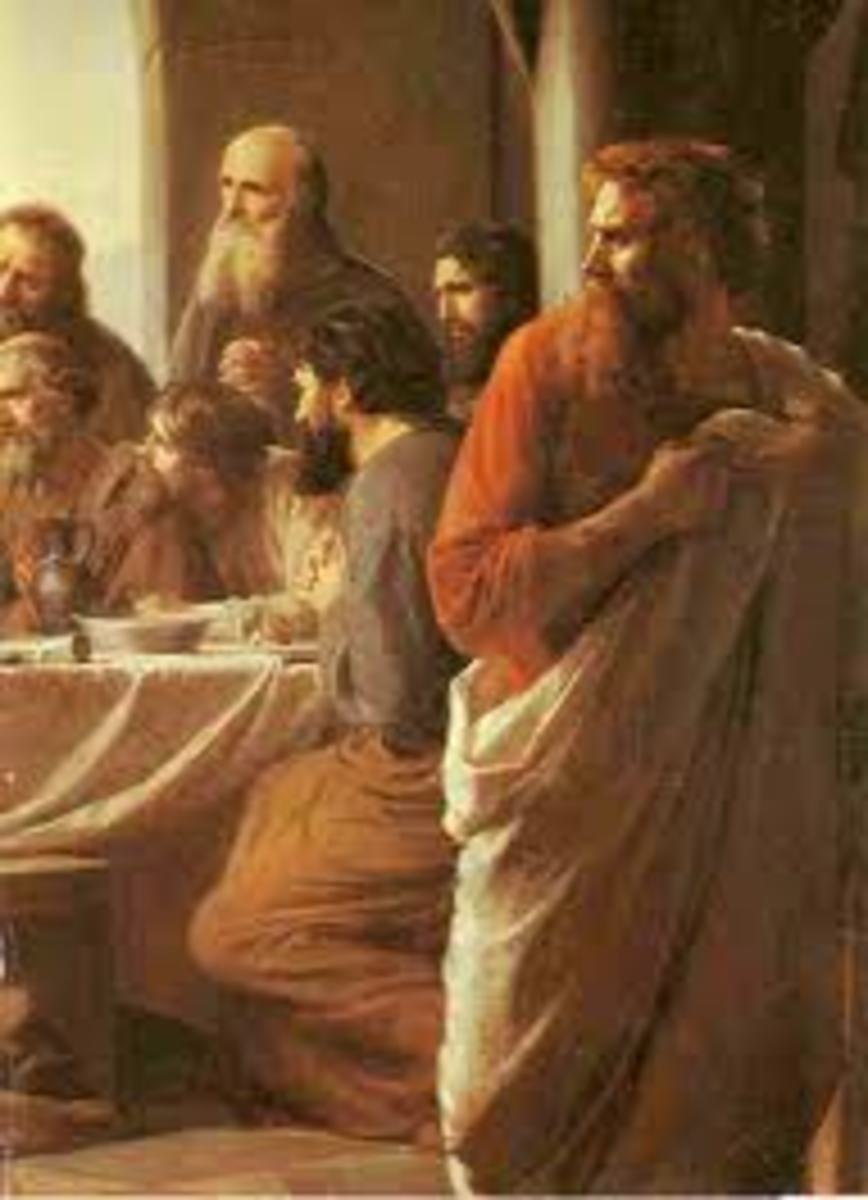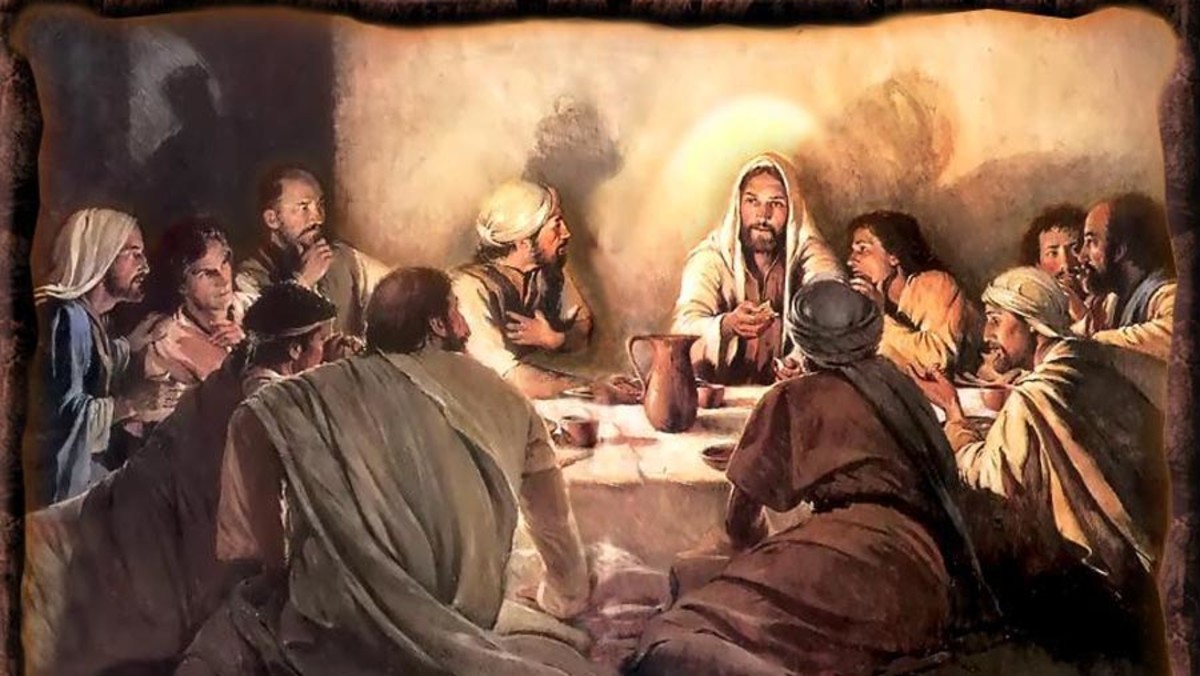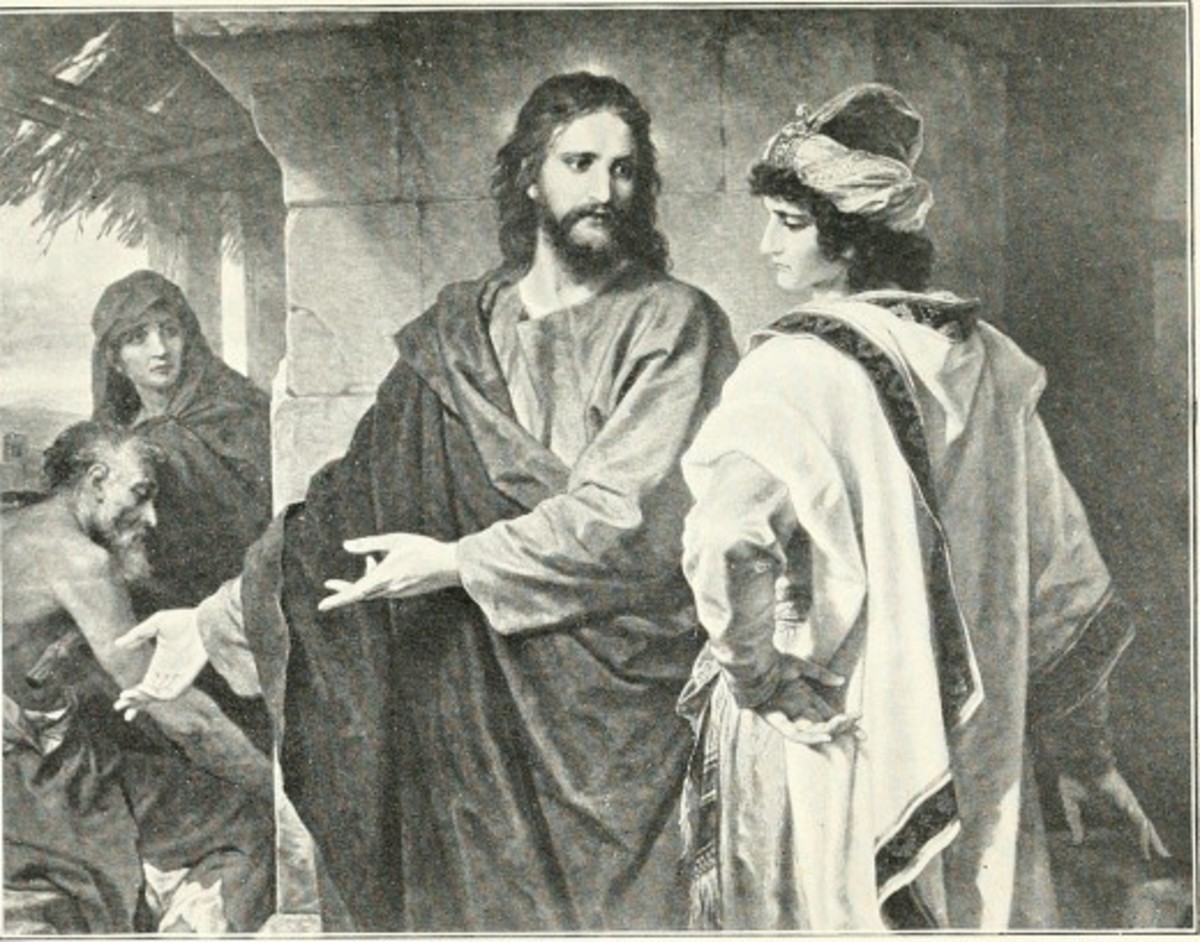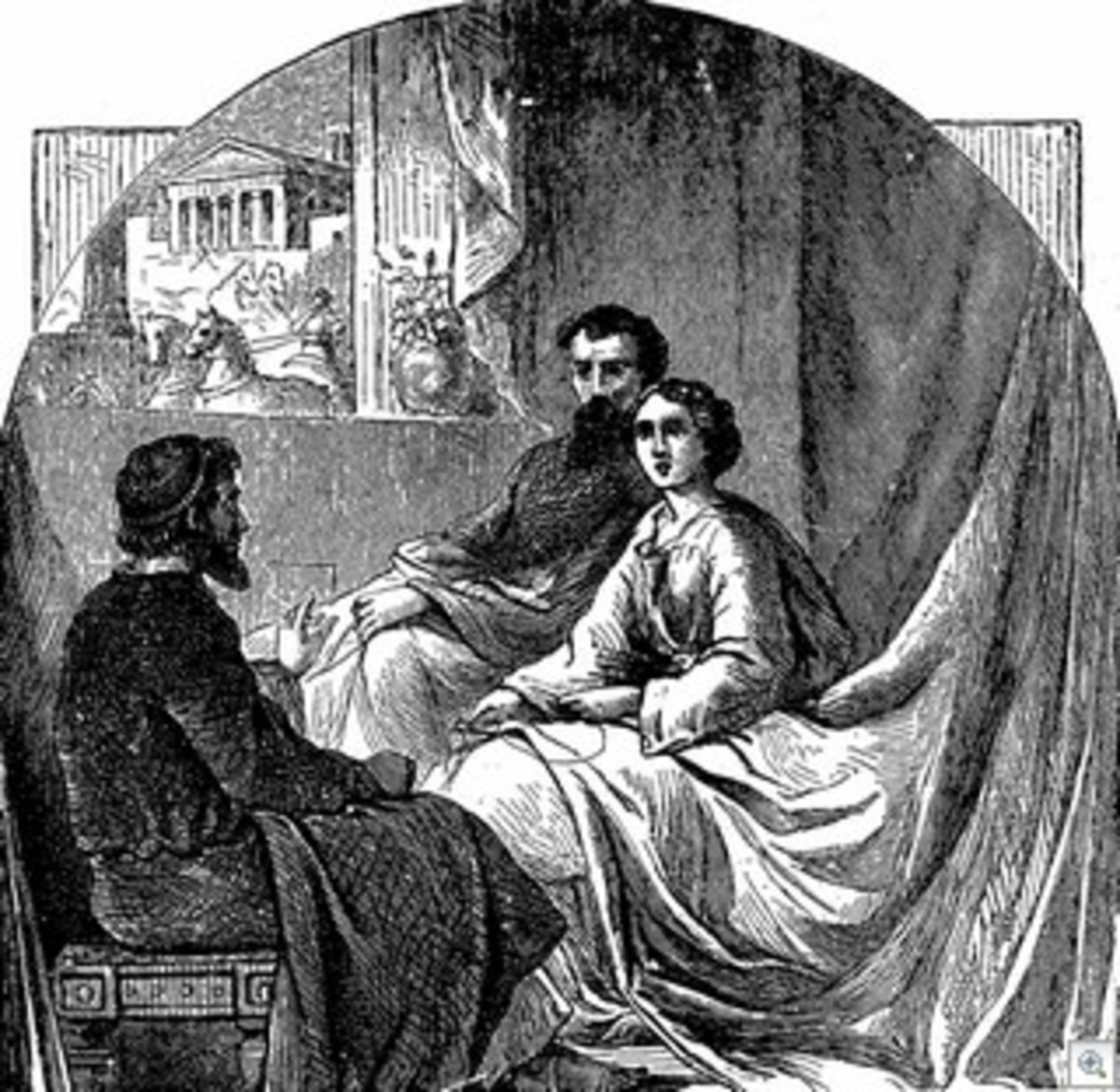Bible: What Does Matthew 26 Teach Us About Jesus' Last Supper, Betrayal, and Passion?
Jesus and His Disciples
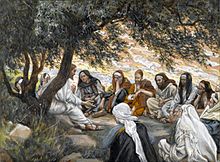
Matthew 26: The "Last Supper," The Passion of the Christ, Judas' Betrayal, Jesus' Trial, and Peter's Denials
Having completed His last discourse, Jesus reminds His disciples of the coming Passover, and foretells His crucifixion (in the third person) once more [vv. 1-2].
Meanwhile, the whole array of His opponents assembles at the high priest Caiaphas’ palace, and conspires to arrest and kill Him (vv. 3-4).
See Ryrie’s note on Caiaphas’ identity (New Testament Study Bible, 56)
They, however, postpone the execution of this plan until after the Feast (v. 5).
Mary Anoints Jesus
While visiting Simon the leper in Bethany, Jesus encounters a woman (Mary, sister of Martha and Lazarus) who pours on His head a vial of oil worth a year’s wages; this action causes His disciples to complain about the waste (vv. 6-9).
Christ, however, takes a different perspective (as one would expect), considering her act a “good work for Me” for which the disciples should not scold her (vv. 10-11).
Acknowledging her spiritual perceptiveness and belief in His word about His death (v. 12), Jesus announces that future evangelists will memorialize this woman’s deed (v. 13).
When Judas Iscariot hears Jesus’ latest prediction of death and burial, he finally concludes in his mind that the Lord is not the Christ and that He is not going to fulfill Zealot expectations and rescue Israel from Rome.
This belief motivates him to agree to “deliver” Jesus to the chief priests for the price of a servant.
See the words of Christ’s prediction (26:2). Ryrie notes that the payment is perhaps about five weeks’ wages (56) [vv. 14-15; cf. Zechariah 11:12].
Judas keeps his eyes open for an opportunity to betray Him (v. 16).
Lord's Supper
Do you believe the Lord's Supper is a sharing in the literal body and blood of Jesus?
Preparations for and the Eating of the "Lord's Supper"
That opportunity comes after the disciples and Jesus eat the Passover meal on the following evening (Thursday).
In the morning of the “first of Unleavened Bread,” the disciples, not knowing where Jesus wanted to eat the Passover, ask Him about this detail, and He directs them to visit a man with whom “the Teacher” had prearranged for the use of his house when “His time was at hand” (vv. 17-18).
Preparations take place, and the thirteen recline to eat (vv. 19-20).
While supping, Jesus reveals the fact of the betrayal (v. 21), causing the disciples to respond with sorrow; each one asks Him if he is the “one” (v. 22).
Observation: Apparently, the faithful eleven also recognize their susceptibility to succumb to pressure in order to save their own skins.
The Lord replies to all of them cryptically that one who dipped his bread with Him will betray Him (v. 23).
Question: Does Jesus answer this way in order to test His disciples’ hearts?
This “going” of the Son of Man—that is, the act of being delivered up to the Jewish authorities through betrayal—is Old Testament prophecy that Jesus will (and must) fulfill.
He pronounces a “Woe” upon the traitor whose punishment exceeds the tragedy of being a miscarriage (v. 24).
Perhaps tellingly, Judas substitutes “Rabbi” for “Lord,” and Christ affirms his perception that he is the one (v. 25).
John records that he was the one who asked Jesus directly, “Who is it?” (cf. 13:25).
The Lord replies, “It is he to whom I give a piece of bread . . .” (underscoring mine).
Perhaps all of the disciples dipped bread into the dish with Him, but only Judas received a piece from Jesus.
After Judas leaves, having received his opportunity to betray Jesus, Christ ratifies the so-called Lord’s Supper (vv. 26-29; cf. John 13:30-31; Matt. 26:16).
The blessed and broken bread He designates “My body” (v. 26), and the blessed and distributed cup of grape juice, “My blood of the new covenant, which is shed for many for the remission of sins” (vv. 27-28).
Jesus calls the “blood” “this fruit of the vine” that He will drink “new with you in My Father’s kingdom” (v. 29).
Comments: It seems obvious that when Christ says “blood,” He does not mean literal blood, but the “blood” of grapes, i.e., grape juice. Otherwise, one can make the case that He will drink His own blood in the millennial kingdom; it could not be His literal blood now, but grape juice in the future kingdom. The juice merely represents His blood; it does not miraculously change into His blood when He blesses it. If the “blood” is only grape juice, then by analogy the bread is not His literal body, but ordinary bread.
Jesus’ reference to “the new covenant” hearkens back to Jeremiah 31:31-33. Christ will ratify this new covenant through His death on the cross, but will fulfill it with the united Jewish people during the Millennium; no literal way exists for the Church to be involved, at least from verse thirty-one (see 1 Corinthians 11 and Hebrews 10). The new covenant is not "according to" the old Mosaic covenant; Moses' law was conditional, and Israel broke it through sin (v. 32).As the fulfillment of the “blessing” aspect of the Abrahamic Covenant (Gen. 12, 15), this "new" one is unconditional and unilateral, meaning that God will fulfill it without Israel's help (v. 33). As the antitypical Lamb of God, Jesus will shed His blood in order that He might forgive and cleanse, not just cover, sins (v. 28; cf. Heb. 10:12-18). As a fitting conclusion to the supper, the Lord and His disciples sing the traditional Passover Hallel (Pss. 115-118), and then head toward the Mount of Olives (v. 30).
The Upper Room
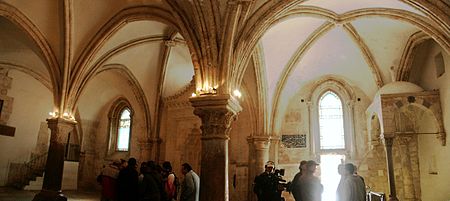
The Upper Room Discourse
While still in the upper room, Jesus relates the comforting message of John 14 to His men; when the group begins its trek to the Garden of Gethsemane, He communicates the messages of John 15-17.
Shortly before they arrive at the Garden, Christ speaks to them about their attitude toward greatness (Lk. 22:24-30).
These parting remarks lead up to the shocking revelation that they would all abandon Him on this night in fulfillment of Zechariah 13:7 (v. 31).
Comment: This prophetic passage indicates that God will strike the Shepherd; God is the One Who metes out justice upon His only Son (cf. Isaiah 53:10.
Accompanying this horrific news, however, Jesus also inserts the prediction of His glorious resurrection and His plan to meet with them in Galilee (v. 32).
Peter altogether loses sight of this latter hope; instead, he focuses his attention on responding to the first part of Jesus’ message, proudly proclaiming that his own strength of will would prevent him from falling away (v. 33).
The Lord sends Peter’s pride crashing down, as He reveals that His apostle will deny Him three times before daybreak (v. 34).
Peter and the others refuse to face up to their cowardice (v. 35).
Jesus and His Disciples at Gethsemane
Finally, Jesus and His men arrive at Gethsemane (“Oil Press”) where the Lord immediately parts with His “inner circle” to pray (vv. 36-37a).
Great sorrow descends upon Christ's soul as He contemplates His “cup” of suffering (vv. 37b-38a).
Though wanting His three leaders to watch with Him, Jesus nevertheless separates Himself from them in order to beg the Father to prevent His death, if He would so will (vv. 38b-39).
Ever concerned for the welfare of His disciples, Christ checks back on their status.
Finding them asleep, He mildly rebukes them (“So,”NASB; What?”NKJV), expressing surprise and/or disappointment at their general inability to “Watch and pray” (v. 40).
He again encourages them to “watch and pray” as a guard against their being solicited to do wrong (“temptation”).
Comment: In this circumstance, does Jesus consider their going to sleep as succumbing to temptation?
Jesus wishes to strengthen their willing spirit so that it can overcome the weakness of their physical body (v. 41).
Returning to prayer, Christ submits to the will of His Father, acknowledging the necessity for Him to drink “this cup” in order for it to “pass away” from Him (v. 42).
Comment: Jesus desires to forego the passion (and all that that horror included), but He willingly submits Himself to the wisdom and love of the Father.
Visiting His disciples once more, the Lord finds them asleep again (v. 43); this time He lets them sleep, and returns to His place to confirm His decision with the Father (v. 44).
One last time Jesus comes upon His sleeping men; His reaction again appears as either surprise or slight disappointment (v. 45a).
Knowing that the hour (of His arrest) has arrived, Christ draws their attention to the coming of His betrayer (vv. 45b-46).
The Betrayer's Kiss
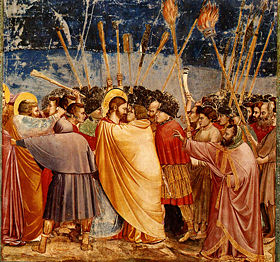
Thursday Questions
view quiz statisticsJudas Betrays His Master
Emerging from “a great multitude” of heavily-armed guards of the chief priests and elders, Judas Iscariot approaches Jesus, greets Him as “Rabbi,” and then kisses the Lord—a sign identifying to the soldiers which One they should arrest (vv. 47-49).
Obviously, Christ does not seek information from Judas by means of His gentle address and question; indeed, He seeks to force His betrayer to confront himself with the horrible sin and crime that he has just committed (v. 50a).
When the guards seize Him, one of the apostles (Peter; cf. John18:10) slices off the ear of the high priest’s servant (Malchus; cf. John 18:10) in a vain, desperate attempt to show Christ his loyalty (vv. 50b-51).
Immediately recognizing the folly of such a rescue bid, Jesus commands His disciples to sheathe whatever weapons they may have brought with them, knowing the disastrous consequences that fighting would bring (v. 52; cf. Lk. 22:38).
The Lord reminds them that if His objective were to defeat His enemies by force, then He would merely ask His Father to send an angelic army (v. 53).
His rescue, of course, runs counter to God’s will, because it would frustrate His eternal, redemptive purposes prophesied in the Old Testament (v. 54).
Addressing the “multitudes” now, Jesus questions their reasoning and their timing.
Comment: The question seems directed toward the Jewish leaders more than toward the multitudes. First, they should have known from His character that He was not going to behave like a robber and fight against them to save His life.Therefore, they need not have come to arrest Him armed to the teeth. To avoid a riot, they decided to arrest Him at nighttime, away from the admiring eyes of those who had accepted His claims while He was teaching daily in the temple.
To make sure that they know the significance of what they are doing, He points out to them that the whole scenario has transpired in order to fulfill prophetic Scripture (v. 56a).
Having answered His own question, Jesus goes away with the guards, and His apostles abandon Him and run away (v. 56b).
The High Priest
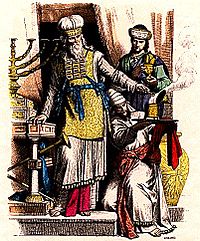
Jesus Among the Pharisees
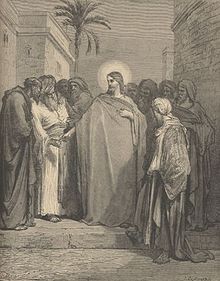
Jesus' Trial Before Annas and Caiaphas
After Annas questions Jesus (see John18:12-14), the Lord appears before Caiaphas’ Sanhedrin (v. 57).
Meanwhile, a cowering Peter sits with the servants in the courtyard outside, awaiting the verdict (v. 58).
Observation: these two snippets introduce the following two scenarios (59-67 and 68-75) respectively.
Matthew’s comment that the Jewish leaders, desperate to destroy Jesus, “sought false witnesses” suggests that they know that Christ is innocent of any wrongdoing (v. 59).
Question: Did they deliberately seek false testimony?
The fact that they can find only two non-contradictory testimonies shows that they do not accept just any false testimony; the witnesses’ account had to possess some credibility.
The Sanhedrin still senses some need to legitimize the trial by adhering to the Jewish law requiring two or three corroborating witnesses (v. 60).
The agreed-upon testimony, recounting a cryptic claim that Jesus made about destroying the “temple” and “rebuilding” it in three days (v. 61), contains enough evidence (in their estimation) for them to proceed with it.
All they need is something that will somewhat stick, so that they can confront Him about His claims.
When Jesus remains silent under their inquisition on this matter (cf. Is. 53:7), the high priest finally “cuts to the chase” by putting Him under oath, commanding Him to tell him if He is the Messiah and therefore equal with God (vv. 62-63).
Not only does Christ acknowledge His deity (yet in an idiomatic way), but He also cites a Messianic prophecy portraying the Son of Man’s coming to judge the people (v. 64; cf. Dan. 7:13).
Believing that he has heard blasphemy—here, a claim to deity by a mere man—the high priest tears his robes and demands a summary judgment from the rest of the Sanhedrin (vv. 65-66a).
With this detail disposed of—“He is deserving of death,” they conclude—these religious leaders (and others) proceed to spit upon, pummel, and mock the Lord (vv. 67-68).
Peter (Post Denials)

Peter' Denials
Meanwhile, Peter encounters people who recognize him as an associate of Jesus.
He claims ignorance of the assertion of a servant girl in the courtyard (vv. 69-70), denies with an oath the claim of another girl at the gateway (vv. 71-72), and curses and swears against the accusations of other bystanders (vv. 73-74a).
Hearing a rooster crowing reminds him of Jesus’ prophecy regarding his three denials (cf. 26:34), and causes him to flee the scene, weeping bitterly for his failure to keep the faith (vv. 74b-75).
© 2013 glynch1


